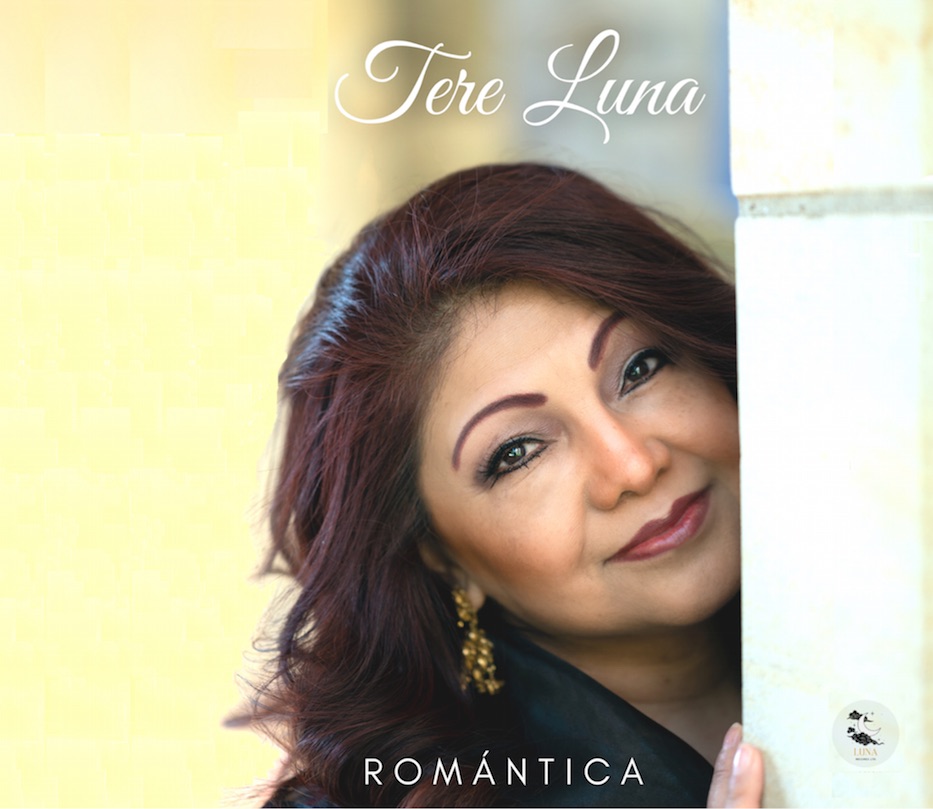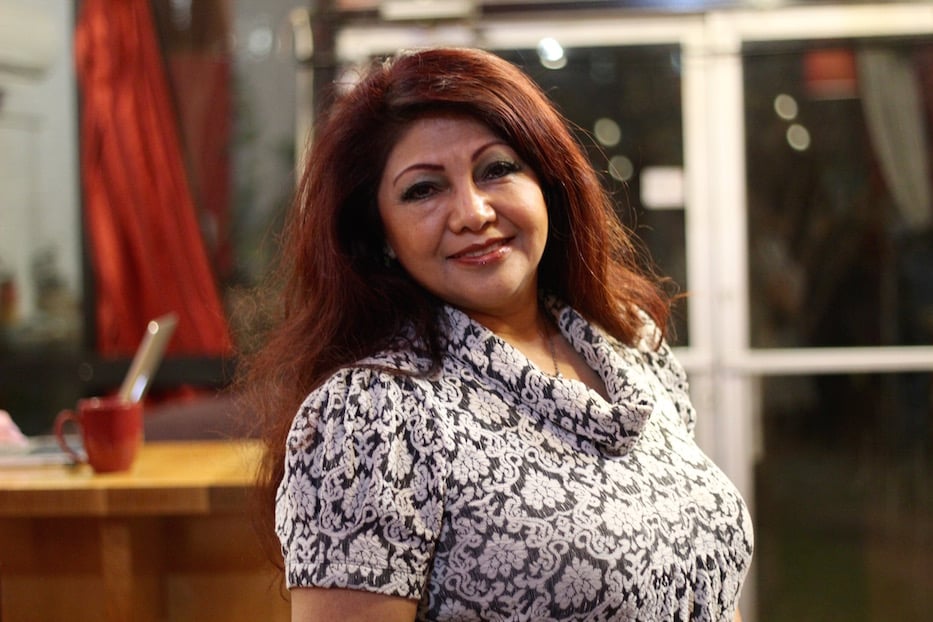
Hamden | Music | Arts & Culture | Arts & Anti-racism

The artist in a recent interview at Koffee? on Audubon Street in New Haven. Lucy Gellman Photos.
The piano is slow, methodical as it plays Tere Luna in. On the mic, she unlocks a songbird from her throat, all sweetness and nostalgia. There’s longing in her voice as she reaches the fifth bar—No me preguntes nadaaaa—and pushes ahead. Strings and percussion pick up the beat. As she barrels toward the song’s climax, a listener can feel themselves sinking into the lyrics. It becomes hard not to dance.
The take on “Cuando vuelva a tu lado” is part of Romántica, the first album by longtime vocalist, dancer, arts educator, and Hamden resident Tere Luna.This fall, Luna released the 11-track album as part of a decades-long wish to share her Mexico City roots with listeners across both Connecticut and the globe. It is now available in physical form as a CD and through streaming platforms including Spotify, iTunes, Apple Music, and YouTube.
“This is a dream come true,” she said in a recent interview at Koffee? on Audubon Street. “I feel very very happy and proud of myself. I just wanted to do it and I wanted to find a way to learn and to keep my goal of practice and dedication [to the art form].”
Luna’s dream of a full album began years ago, as her passion for Mexican arts and culture helped her bridge the gap between her birthplace and her adopted home. Born and raised in Mexico City, the singer grew up in a house that was always full of music. Her parents liked to sing and dance around the house; they had a particular love for the bolero that now flows through Romántica from its first notes to its last track. When the family went out to celebrate a birthday or anniversary, “there was always music,” she said.
As a kid, she also developed a taste for the rock and disco she was hearing from her two older sisters, who pumped out a steady stream of Black Sabbath, Jim Morrison, Creedence Clearwater Revival, and Donna Summer to soothe their teenage angst. When she was seven, she took part in her first formal dance lessons at school, based on Indigenous Aztec customs that are still alive and vibrant in Mexico today. When she put on the brightly embroidered huipil and long skirt and picked up noisemakers, something came over her.
“It was just magical,” she remembered, with a kind of enchantment that a listener can hear woven into the album. “From then, it clicked in me that this is really what I want to do.”
Luna started taking singing and dance lessons, often pretending that the broom handle was her microphone when she did chores around the house. She hammed it up for homemade music videos with her younger brother, trying to master the stylings of Olivia Newton-John from Greece. She ultimately brought her love for dance with her to college, studying jazz and ballet alongside hotel management. It was around that time that she made the move from Mexico City to Texas, following her then-husband to a new artistic chapter in Houston. After four years in Houston, they moved to Northern Connecticut.
For a time, she said, music went on the back burner as she adjusted to her new home state. Luna became a mother twice over, raising sons over whom she still beams and gushes when they come up in conversation. When they were young, she approached their schools and offered to teach students about Mexican arts and culture. At the time, she said, no one was doing that kind of work; organizations like Hartford Performs didn’t yet exist. To sustain herself as an artist, she also picked up a full-time job in healthcare.
“Kids love the movement of the dances,” she said. “And life is better” with live performance. She began to teach anywhere she could, branching out from her kids’ schools to town and city libraries, and the Mariachi Academy of New England. Val Ramos, who helms the Val Ramos Flamenco Ensemble and is now her partner, met her during those years. He first heard her sing in 2008, and remembered feeling “very moved” by her voice and emotion from the first notes.
“I loved the way she sang,” he said in a phone call Wednesday night, adding that she seemed so incredibly full of life. The two became frequent collaborators as she deepened her work in flamenco and bolero.
When Hartford Performs announced it was looking for teachers five or six years ago, Luna applied to work with the organization, and began with a portfolio of 30 schools. She has since grown her footprint to all of the schools in Hartford, where she teaches both folkloric dance and meditation to students. She said that students are often very excited to get up and dance, or to sit and learn how to calm themselves through meditation. That sense of ease flows through Romántica in works like “Sabor a Mí,” a bolero standard from Álvaro Carrillo that Luna scales comfortably, soaring over the horns and strings as if it’s no big deal.
“It’s so important for the kids to be focused and not to be afraid,” she said of her classes. “This is a good tool for them. Sometimes they forget to breathe and it’s so important to have that breathing, that oxygen.”
At home, she also nurtured her love for bolero, a genre of love song that she can trace from nineteenth-century Cuba to her childhood living room in Mexico to her adult life in Connecticut. Every time she performs it, she said, she thinks about her parents and is able to sing across the distance that now separates them. Four years ago—her kids are now grown, which has given her more time for her music—she was able to record an original single, “Sin tu amor muere mi alma” that Ramos wrote for her. She realized she wanted to do more.
“I decided that I wanted to record some backup tracks,” she said. Over several months, she made plans to travel back to Mexico, where she could work with mentors José Antonio Hernández and Ignacio Gutiérrez Campoy. But as she carved out the time in which she could travel, the Covid-19 pandemic hit both Mexico and the U.S. Borders closed. She suddenly found herself at home, teaching choreography classes on a screen.
She ultimately made it back to Mexico City this July, where she was able to record the album while visiting with her family after two years away. Six tracks come from her work with Hernández; five are collaborations with Campoy. She said that she thinks of the work as an homage to her parents, without whom she never would have pursued music. When she recorded, “they were there with me,” listening as she put a new spin on work by Carlos Eleta Almarán, Consuelo Velázquez, Ema Elena Valdelamar, Armando Manzanero and others.
It’s a way of keeping the past alive, she said. In the finished work, she dips into the long and storied history of bolero and also makes the songs completely her own. She opens “Cuando vuelva a tu lado” with a sort of melancholic, sultry preamble, her voice so wispy it feels like a ghost. In “Historia de un amor,” the first track on the album, her voice does a slow, smoldering dance with violin and keys. When drums and a shaker enter the fray, it’s hard to stay still. By “Total,” she is all warmed up and crooning between easy brass and guitarra. In “La Gloria Eres Tú,” she all but extends a hand and invites her listeners to dance hip to hip.
Originally, Luna had planned to launch the album exclusively through digital platforms. But something about its content—it is meant to channel, celebrate and enliven the past—told her to turn it into a physical album. In October of this year, she released it at a small party and concert in Hartford. She joked that promotion has become “like a full-time job” on top of her work for Hartford Performs.
Following the album’s release this year, Luna said that she is hopeful that Romántica can transport her listeners to a different era with its sound alone. She loves performing in senior centers, where she can see the way music moves residents as soon as she has lifted the mic to her mouth and let out a few notes.
“It’s nice that I can bring memories back to people who listen to my music … I’m just blessed that I have this voice that moves people,” she said.
She also hopes that as word of the album gets out, fellow artists, venues and organizations will take her craft more seriously. Not infrequently, she said, she’s still asked to perform for free, or will come to a performance just to learn that the band is making more per person because they have instruments, and she has only her voice. She’s found herself telling people “Sorry, I can’t do it for fun!” she said with a laugh.
Romántica, which her family and friends have already rallied around, feels rewarding in a way that those gigs sometimes do not. She is balancing promotion of the album with a new interest in mindfulness and meditation, for which she will be releasing a recorded mantra in the next months.
“This is for me,” she said. “That respect that I really have for people who enjoy listening to my music. To me, if people listen to the music, it’s wonderful. I don’t want to be famous. I just want to sing.”
Echoing her Wednesday, Ramos pointed to the sheer reach of Romántica. The album has given Luna’s voice a way to travel around the globe in the time it takes to download a song, press a play button, make a payment in iTunes, or slip a disk into a CD player. He said he feels lucky to watch her career bloom into its next stage.
“We’re inseparable, and that makes our relationship even better,” he said. “I love seeing her career really pick up. Her music really is all over the world.”
Find out more about Tere Luna on her website, Instagram, Facebook or YouTube. Romántica is available now via album, streaming, or download.

